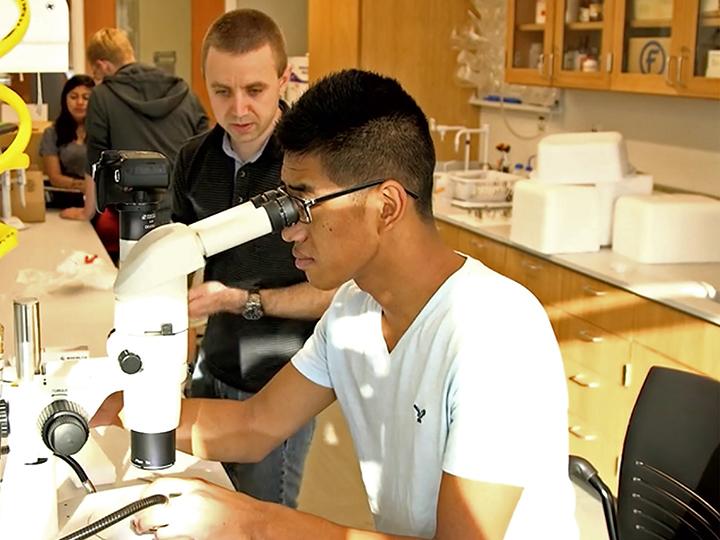Student benefits -- Recipient of a National Science Foundation Early Career Development Grant, Christopher Chandler, one of six SUNY Oswego faculty who have reached award-winning levels of cumulative external funding, works with then-student Yadong Wang in a biological sciences lab. A strategic effort is under way to encourage more grant submissions from faculty members in disciplines across campus.
As the college prepares to recognize six faculty members who've reached medal-winning levels of cumulative external funding through pursuing grants, the Office of Research and Sponsored Programs continues a cross-campus effort to broaden the numbers and academic disciplines represented by faculty who seek grants.
"How can we involve more faculty?" William Bowers, associate provost for research development and administration, asked rhetorically. "Some faculty are intimidated by the process. Part of my job is to be a cheerleader and to help with navigating what is viewed by many as a challenging endeavor.
"Success breeds success," he continued. "We have been broadening that involvement. We are looking for champions in each department."
At the Academic Affairs Retreat in August, Bowers will present Jean Hallagan of curriculum and instruction, Sofia Windstam of biological sciences and Nichole Brown, director the School of Education's Field Placement Office, with gold medals for reaching $1 million in cumulative external funds during their careers here.
At the $500,000, silver medal, level are biological sciences faculty members Peter Rosenbaum and Christopher Chandler.
Ching Hung Hsiao of modern languages and literatures has reached $250,000 in cumulative external funds, the bronze medal level.
In a letter to the honorees, Bowers wrote, "This award not only highlights your impressive ability to procure external monies in the highly competitive funding environment that we currently face and the innovative nature of your research program, but also truly epitomizes your strong commitment to academic and scholarly excellence at SUNY Oswego."
In a recent interview, he said of the Awards of Excellence, "We promote and recognize research. This is an important component of showing our appreciation for this hard work."
'Sweet spot'
Scott Furlong, college provost and vice president for academic affairs, said external grants are important to SUNY Oswego in a variety of ways.
"Clearly they provide resources to faculty to continue to pursue their research interests," Furlong said. "But because of what we value, these resources often provide significant research opportunities for our students. These engaged learning experiences, such as undergraduate research, allow students to problem solve, develop their own hypotheses and questions, and engage in the research necessary to answer them.
"Oftentimes these grants allow SUNY Oswego to better deliver or enhance programs to our students and the larger community," he continued. "They can also help to provide a critical component to a student's education. Whether it's research on the fresh water of the Great Lakes, supporting students' ability to take part in a student teaching residency program, or helping transfer students better transition to SUNY Oswego, these grants significantly enhance the education environment and help our students be successful."
Bowers arrived at SUNY Oswego in 2014 from the biotechnology sector after more than a decade serving as faculty member at a private, research-focused (R1) institution, the University of Rochester, where earning grants is crucial to fiscal stability and the livelihoods of faculty members.
Oswego is in a "sweet spot" when it comes to external funding, Bowers said. Salaries at SUNY colleges are on state lines, so external funds mostly can go toward paying for student research assistants, conference travel, equipment, and course releases/summer pay for busy faculty researchers, he said.
External funding has grown steadily at Oswego, from $5 million in 2011-12 to $5.8 million in 2017-18, according to Academic Affairs annual reports. The numbers of annual grant submissions have, too, from 43 in 2011-12 to 90 in 2017-18.
Much of that external support inures directly to the benefit of students, Bowers said, and serves as an important tool for academic growth and retention for both students and faculty members.
"Oswego has the nice, full view of what research should be doing at this level," he said. "We want research to positively impact not only the scholarly/creative fields and career trajectories of our faculty members, but also to enrich the experiences and skillsets of our students."
'Valuable insight'
Thanks to Oswego's status as a SUNY comprehensive college, the Office of Research and Sponsored Programs has four professional staff -- including Bowers -- employed by Oswego, and also has three grant-making/administering associates of the Research Foundation of SUNY. Everyone is on board to assist faculty members through the application, budgeting, and accounting processes, Bowers said.
"We're also trying to develop grant-active faculty groups in each department or discipline who would be willing to serve as peer reviewers of applications before they are submitted to external sponsors," he said. "Discipline-level review provides valuable insight to the applicant as to how impactful a particular project may be and may identify missing information/data or errors prior to submission. Departments at the University of Rochester that instituted this internal review process had really high funding success rates."
The college has a unique Early Start Program that has attracted 9 to 12 newly hired tenure-track faculty a year. They opt to arrive on campus by July 1 and receive intensive, deadline-driven oversight putting together their first external grant applications before classes start in the fall.
"How do we enhance your (academic) portfolio and your career, but also involve more students?" Bowers asked, again rhetorically.
The Office of Research and Sponsored Programs (ORSP) will be there to help provide centralized assistance, trackable reporting and accountability, he said.
For more information, contact ORSP at 315-312-3177 or orsp@oswego.edu.




